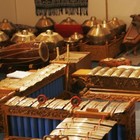Sonata for Horn and Piano - Mvt. II
This is the second movement of my horn and piano sonata, with elements of Romantic/Impressionist literature as well as Javanese gamelan.
I am a graduate of the University of Hawaii at Manoa with a degree in music composition. This goes without saying but I love music (listening, composing, studying, performing).
Story behind the song
This is the second movement of my "Sonata for Horn and Piano" (written first). It was based on an older piece and finished quickly for insertion into the University of Hawaii Young Composers' Symposium for Fall 2007.
This movement is not programmatic at all. In fact it is a blend of different styles. The first half (m.1 through m.63) is almost straight out of an older horn piece I began writing in early 2007. For the very beginning (mm.1-12), my influences were jazz, the Impressionists, and some of my own improvisation, especially for the beginning. The lyrical section from mm.13-63 was inspired by Franz Strauss' "Nocturno" for horn and piano. I wanted to let the horn sing here.
The second half from m.64 on was "rush-composed" in a couple of weeks when I decided to finish this for inclusion into the composers' symposium. From its nice lyrical mood, the movement becomes darker and more mysterious. Here I drew of course from the beginning of the movement, but also from Debussy's "Pagodes." Like Debussy, Javanese gamelan was another influence, although only hints of it are here.
This section speeds up and changes key into the next part, very heavily influenced by Javanese gamelan. Mm. 82-106 are quoted directly from the slendro manyura Ayak-Ayakan (complete with the characteristic speed changes), as seen in the piano left hand. Here the horn plays a newly composed line influenced by a suling part I heard on a recording of this Ayak-Ayakan. The right hand is just some pentatonic stuff; I tried to imitate what I thought the gambang or gender was doing but I haven't actually learned them yet.
It speeds up but rather than going to the srepegan (or palaran some other piece) it transitions to my favorite section. The piano right hand is based off some bonang patterns for a gangsaran I played, but, because I am a Westerner I transpose it and do other stuff to it. The left hand emulates the gongs/kempul/kethuk, but I seem to blend the accent on beat 1 and beat 4. The piano is the star here; the horn merely does some little fill-in things. Of course the ending is influenced by the final gong of a gendhing.
EDIT: I edited and extended the final section so it flows better and drives that gamelan feel (it actually uses the pitch progression from Srepegan/Sampak manyura now), and the horn gets a nice solo line that is supposed to float above the piano. This recording combines an EWQLSO horn with PianoTeq piano.
Comments
The artist currently doesn't allow comments.

